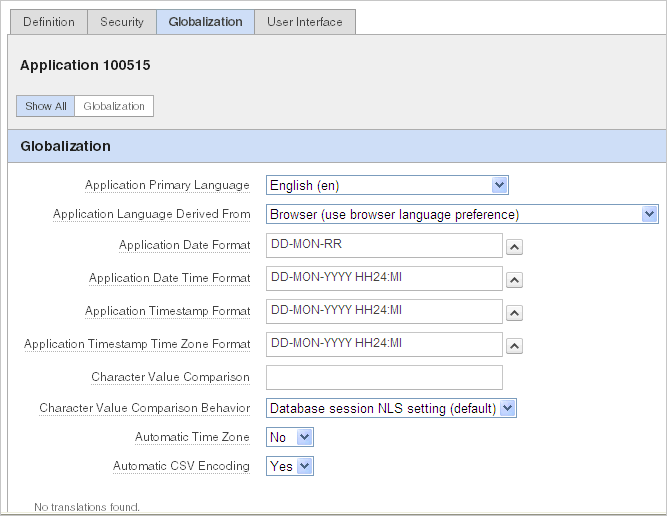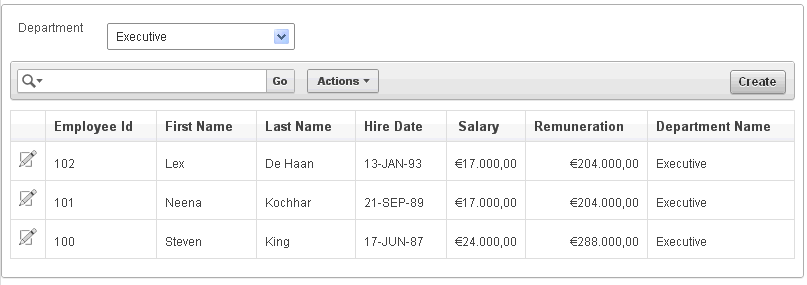6 About Globalization
This section provides some basic information about globalization. It also leads you through the steps to specify how the application determines global identification.
See also:
"Managing Application Globalization" in Oracle Application Express Application Builder User's Guide6.1 About Language Identification and Rendering
You can develop applications in Application Builder that run concurrently in different languages. This feature enables different users to view the application in their own language and data in the appropriate formats.
When rendering a page in the application, Oracle Application Express first determines the language for an application based on the method you specified. Then, the Application Express engine alters the session language and territory settings for a specific page request. It then looks for a translated application in the appropriate language. If the Application Express engine finds that language, it renders the application using that definition. Otherwise, it renders the application in the base (or primary) application language.
Even if your application is not translated, the language display determines the format for displaying data so that end users view numbers, dates, and currency in the appropriate formats.
6.2 Specifying the Method for Global Identification
As part of the application definition settings, you can specify how the application determines which language and formats to display. You can base it on the user's browser language preference or restrict it to the language you specify.
To specify the method for determining global identification:
-
Click Application Builder.
-
Select the application.
-
Click Shared Components.
-
Under Globalization, click Globalization Attributes.
-
Under Globalization, specify the following:
-
Application Primary Language - Select the language you used when developing the application.
-
Application Language Derived From - Select Browser (use browser language preference).
This option enables users to view the application in the language specified in their browsers.
-
Application Date Format - Specify the date format to be used in the application.
-
Application Date Time Format - Specify the date time format to be used in the application.
-
Application Timestamp Format - Specify the timestamp format to be used in the application.
-
Application Timestamp Time Zone Format - Specify the timestamp with time zone format to be used in the application.
-
Character Value Comparison - Determines the collating sequence for character value comparison in various SQL operations and clauses, for example, ORDER BY, LIKE, MIN/MAX. To learn more, see item Help.
-
Character Value Comparison Behavior - Determines the collation behavior of SQL operations, for example, LIKE, MIN/MAX. To learn more, see item Help.
-
Automatic Time Zone - Controls the setting of the database session time zone. When set to Yes, the client time zone is derived from the client's web browser and set for the duration of the Application Express session.
-
Automatic CSV Encoding - Select Yes or No.
Automatic CSV Encoding controls the encoding of all comma-delimited (CSV) report output in an application. If Automatic CSV Encoding is set to Yes, CSV report output is properly converted to a character set compatible with localized desktop applications. The character set for the CSV encoding is determined by the Application Language Derived From setting.

Description of the illustration glb_settings.gif
-
For example, the end user whose browser setting is German (de) sees these changes on the Employees page of AnyCo Corp:
-
The euro currency symbol appears for the amounts in the Salary and Remuneration columns.
-
The amounts reflect the formatting used in Germany (commas and decimals).

Description of the illustration glb_german.gif
The application fields are not yet translated. For instructions on translating your application, see "Managing Application Globalization" in Oracle Application Express Application Builder User's Guide.